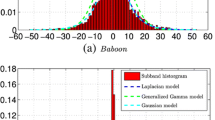Abstract
In this paper, we propose a steganalysis method based on the principle of additive operator, which chooses non-zero AC coefficients as carriers, with secret information independent of the carrier information flow. In the proposed method, AC coefficient statistical and energy features are initially extracted and used to construct a 3D feature vector. By employing the principle of Fisher linear discriminate analysis, a flexible discriminate classifier suitable for the extracted features is designed to improve detection performance. We infer and confirm theory of change in the statistical and energetic characteristics of the AC coefficient before and after additive steganography. The effectiveness of the proposed method is proven by the experiments. Moreover, the proposed method consistently outperforms related methods.









Similar content being viewed by others
References
Awrangjeb M, Lu G (2008) A robust content-based watermarking technique. MMSP 2008,MMSP 2008, Cairns, Queensland, Australia, pp. 713–718
Bian ZQ, Zhang XG (2005) Pattern recognition. Tsinghua University Press, BeiJing, pp 87–90
Briassouli A, Tsakslides P, Stouraitis A (2007) Hidden messages in heavy-tails: DCT-domain watermark detection using alpha-stable models. IEEE Trans Multimedia 7(3):700–715
Chen GM, Chen Q, Zhang D, Zhou DN (2014) Steganalysis based on distribution characters of stego-images in reduced dimension space. Multimedia Tools Appl 71(2):497–515
Cheng Q, Huang TS, Leighton T, Shamoon T (2001) An additive approach to transform-domain information hiding and optimum detection structure. IEEE Trans Multimedia 3(3):273–284
Dai ZH and Qi X (2012) Research on the large scale image steganalysis technology based on cloud computing and BP neutral network. 2012 Eighth International Conference on Intelligent Information Hiding and Multimedia Signal Processing, pp. 415–419
Fridrich J (2004) Feature-based steganalysis for JPEG images and its implications for future design of steganographic schemes. Proc.of the 6th Information Hiding Workshop, Springer-Verlag Berlin Heidelberg, pp. 67–81
Fridrich J, Goljan M, Hogea D (2002) Setganalysis of JPEG image: breaking the F5 algorithm. Information Hiding 5th International Workshop, Netherlands, pp. 310–323
Fridrich J, Goljan M, Soukal D (2005) Perturbed quantization steganography. Multimedia System. Proc. of the 6th Information Hiding Workshop 11(2):98–107.
Giannlual A, Boulgouris NV, Hatzinakos D, Platanitis KN (2006) Watermark detection for noisy interpolated images. IEEE Trans Circuits Syst 53(5):359–403
Hernadez JR, Amado M, Gonzalez FP (2000) DCT-domain watermarking techniques for still images: detector performance analysis and a new structure. IEEE Trans Image Process 9(1):55–68
Hou XD, Tao Z, Xiong G (2014) A novel steganalysis framework of heterogeneous images based on GMM clustering. Signal Process Image Commun 29(3):143–154
Jafari R, Ziou D, Rashidi MM (2013) Increasing image compression rate using steganography. Expert Syst Appl 40(17)
Kazem Q, Reza S (2014) A new steganography method which preserves histogram: generalization of LSB++. Inf Sci 277:90–101
Lee YK, Hwang SY, Ou ZH (2006) A novel quantity based on clipping statistics for Jsteg steganalysis. 8th IASTED Int. Con. On Signal & Image Processing (SIP 2006), Honolulu, Hawaii, USA, pp. 14–16
Li B, Shi Y, Huang JW (2009) Steganalysis of YASS. IEEE Trans Inf Forensics Secur 4(3):369–382
Lie WN, Lin GS (2005) A Feature-based classification technique for blind image steganalysis. IEEE Trans Multimedia 7(6):1077–1020
LiFang Y, Yao Z, RongRong N (2014) A channel selection rule for YASS. Sci Chin Inf Sci 87(8):1–10
Lingyun X, Xingming S, Gang L (2014) Linguistic steganalysis using the features derived from synonym frequency. Multimedia Tools Appl 71(3)
Liu QZ, Cooper PA, Chen L (2013) Detection of JPEG double compression and identification of smartphone image source and post-capture manipulation. Appl Intell 39(4):705–726
Liu Q, Sung A, Qiao M, Chen Z, Ribeiro B (2010) An improved approach to steganalysis of JPEG images. Inf Sci 180(9):1643–1655
Natarajan V, Anitha R (2012) Universal steganalysis using contourlet transform. Adv Comput Sci Eng Appl AISC 167:727–735
Ogihara T, Nakamura D, Yokoya N (1996) Data embedding into pictorial with less distortion using discrete cosine transform. In Proc.ICPR’96, Vienna, Austria 1996, pp. 675–679
Pevny T, Fridrich J (2007) Merging Markov and DCT features for mutli-class JPEG Steganalysis. Proceedings of SPIE Electronimc Imaging, Secruity, Steganography, and Watermarking of Multimedia Contents IX. San Jose, CA, USA, 6505, pp. 650503-1–650503-13
Shi YQ, Chen C, Chen W (2006) A Markov process based approach to effective attacking JPEG steganography. Information Hiding 8th international workshop, Berlin, Germany: Springer Berlin, 4437, pp. 249–264
Swaminathan A, Wu MK, Liu JR (2008) Digital image forensics via intrinsic fingerprints. IEEE Trans Inf Forensics Secur 3(1):101–117
Wang Y, Moulin P (2007) Optimized feature extraction for learning-based image steganalysis. IEEE Trans Inf Forensics Secur 2(1):31–45
Wang C, Ni J (2012) An efficient JPEG steganographic scheme based on the blook entropy of DCT coefficients. Proceeding of IEEE ICASSP 2012, Kyoto, Japan, pp. 1785–1788
Wu M, Yu H, Lui B (2003) Data hiding in image and video: pat-designs and applications. IEEE Trans Image Process 12(6):696–705
Yang HJ, Kot A (2007) Pattern-based data hiding for binary image authenticationby connectivity-preserving. IEEE Trans Multimedia 9(3):475–486
Yang CH, Weng CY, Wang SJ, Sun HM (2008) Adative data hiding in edge of images with spatial LSB domain systems. IEEE Trans Inf Forensics Secur 3(3):488–497
Yih-Kai L (2014) A data hiding scheme based upon DCT coefficient modification. Comput Stand Interfaces 36(5):855–862
Zhan-He O, Ling-Hwei C (2014) A steganographic method based on tetris games. Inf Sci 276:343–353
Acknowledgments
The authors thank Jiangqun Ni research team in Sun Yat-sen University, China, they provide EBS steganography tool software. This work is supported by the National Natural Science Foundation of China (No. 61170271, 61272310, 61203288) and the ZheJiang province Natural Science Foundation of China (No. LY15F020032,LY12F02031).
Author information
Authors and Affiliations
Corresponding author
Rights and permissions
About this article
Cite this article
Jia-Fa, M., Xin-Xin, N., Gang, X. et al. A steganalysis method in the DCT domain. Multimed Tools Appl 75, 5999–6019 (2016). https://doi.org/10.1007/s11042-015-2708-0
Received:
Revised:
Accepted:
Published:
Issue Date:
DOI: https://doi.org/10.1007/s11042-015-2708-0




